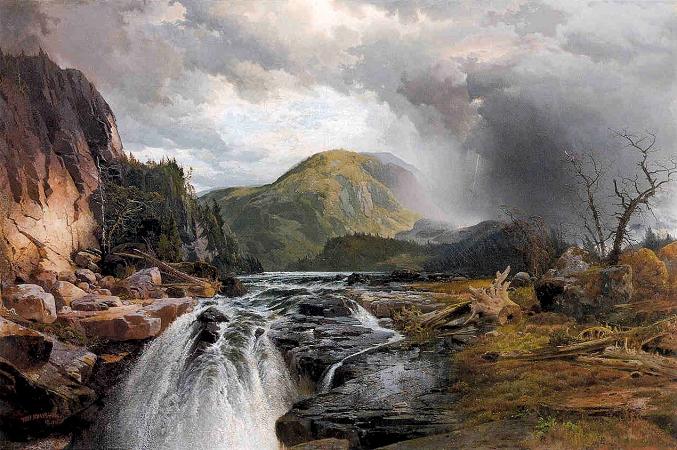Lake Superior. Lake Superior in central North America is the largest freshwater lake in the world by surface area and the third-largest by volume, holding 10% of the world's surface fresh water. The northern and westernmost of the Great Lakes of North America, it straddles the Canada-United States border with the province of Ontario to the north, and the states of Minnesota to the northwest and Wisconsin and Michigan to the south. It drains into Lake Huron via St. Marys River, then through the lower Great Lakes to the St. Lawrence River and the Atlantic Ocean. The Ojibwe name for the lake is gichi-gami, meaning great sea. Henry Wadsworth Longfellow wrote this name as Gitche Gumee in the poem The Song of Hiawatha, as did Gordon Lightfoot in his song The Wreck of the Edmund Fitzgerald. According to other sources, the full Ojibwe name is Ojibwe Gichigami or Anishinaabe Gichigami. The 1878 dictionary by Father Frederic Baraga, the first one written for the Ojibway language, gives the Ojibwe name as Otchipwe-kitchi-gami. In the 17th century, the first French explorers approached the great inland sea by way of the Ottawa River and Lake Huron; they referred to their discovery as le lac superieur. Some 17th-century Jesuit missionaries referred to it as Lac Tracy. After taking control of the region from the French in the 1760s following their defeat in the French and Indian War, the British anglicized the lake's name to Superior, on account of its being superior in magnitude to any of the lakes on that vast continent. Lake Superior empties into Lake Huron via the St. Marys River and the Soo Locks. Lake Superior is the largest freshwater lake in the world in area and the third largest in volume, behind Lake Baikal in Siberia and Lake Tanganyika in East Africa. The Caspian Sea, while larger than Lake Superior in both surface area and volume, is brackish. Though presently isolated, prehistorically the Caspian has been repeatedly connected to and then isolated from the Mediterranean via the Black Sea. Lake Superior has a surface area of 31,700 square miles, which is approximately the size of South Carolina or Austria. It has a maximum length of 350 statute miles and maximum breadth of 160 statute miles. Its average depth is 80.5 fathoms with a maximum depth of 222.17 fathoms. Lake Superior contains 2,900 cubic miles of water. There is enough water in Lake Superior to cover the entire land mass of North and South America to a depth of 30 centimetres. The shoreline of the lake stretches 2,726 miles. American limnologist J. Val Klump was the first person to reach the lowest depth of Lake Superior on July 30, 1985, as part of a scientific expedition, which at 122 fathoms 1 foot below sea level is the second-lowest spot in the continental interior of the United States and the third-lowest spot in the interior of the North American continent after Great Slave Lake in the Northwest Territories of Canada and Iliamna Lake in Alaska. While the temperature of the surface of Lake Superior varies seasonally, the temperature below 110 fathoms is an almost constant 39 °F. This variation in temperature makes the lake seasonally stratified. Twice per year, however, the water column reaches a uniform temperature of 39 °F from top to bottom, and the lake waters thoroughly mix. This feature makes the lake dimictic. Because of its volume, Lake Superior has a retention time of 191 years. Annual storms on Lake Superior regularly feature wave heights of over 20 feet. Waves well over 30 feet have been recorded. Lake Superior is fed by more than 200 rivers, including the Nipigon River, the St. Louis River, the Pigeon River, the Pic River, the White River, the Michipicoten River, the Bois Brule River and the Kaministiquia River. The lake's outlet at St. Marys River has a relatively steep gradient with rapids. The Soo Locks enable ships to bypass the rapids and to overcome the 25-foot height difference between Lakes Superior and Huron.
more...






